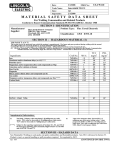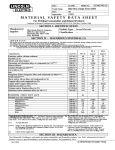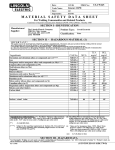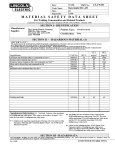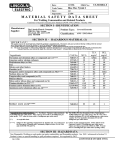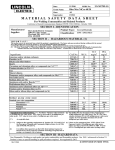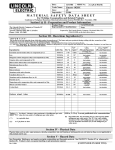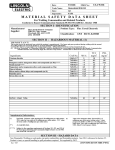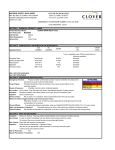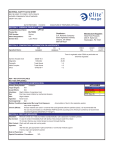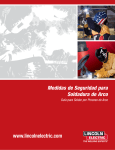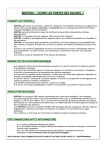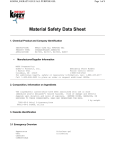Download Weldex US-W205M User's Manual
Transcript
Date: 2/20/07 Trade Name: Sizes: Supersedes: Murematic S6 US-W205M MSDS No.: All 3/16/00 MATERIAL SAFETY DATA SHEET For Welding Consumables and Related Products Conforms to Hazard Communication Standard 29CFR 1910.1200 Rev. October 1988 SECTION I - IDENTIFICATION Manufacturer/ Supplier: The Lincoln Electric Company 22801 St. Clair Avenue Cleveland, OH 44117-1199 (216) 481-8100 Product Type: Carbon Steel Electrode Classification: AWS ER70S-6 SECTION II - HAZARDOUS MATERIAL (1) IMPORTANT! This section covers the materials from which this product is manufactured. The fumes and gases produced during welding with the normal use of this product are covered by Section V; see it for industrial hygiene information. CAS Number shown is representative for the ingredients listed. (1) The term “hazardous” in “Hazardous Materials” should be interpreted as a term required and defined in the Hazards Communication Standard and does not necessarily imply the existence of any hazard. All materials are listed on the TSCA inventory. Ingredients: CAS No. Carbon steel wire Wt.% TLV mg/m3 PEL mg/m3 100 10* 10* < 2.0 < 0.5 bal. 0.2 0.2(a) 10* 1.0(c) 0.1(a) 10* Nominal wire composition: Total manganese ***** Total copper including plated coating ***** Iron Supplemental Information: (*) Not listed. Nuisance value maximum is 10 milligrams per cubic meter. PEL value for iron oxide is 10 milligrams per cubic meter. TLV value for iron oxide is 5 milligrams per cubic meter. (*****) 7439-96-5 7440-50-8 7439-89-6 (c) Subject to the reporting requirements of Sections 311, 312, and 313 of the Emergency Planning and Community Right-to-Know Act of 1986 and of 40CFR 370 and 372. (a) Values are for manganese fume. STEL (Short Term Exposure Limit) is 3.0 milligrams per cubic meter. Values are those proposed by OSHA in 1989. Present PEL is 5.0 milligrams per cubic meter (ceiling value). Values are for copper fume. SECTION III - HAZARD DATA Non Flammable; Welding arc and sparks can ignite combustibles and flammable products. See Z49.1 referenced in Section VI. Product is inert, no special handling or spill procedures required. Not regulated by DOT. Rev 11/06 (CONTINUED ON SIDE TWO) Product: Murematic S6 Date: 2/20/07 SECTION IV - HEALTH HAZARD DATA 3 Threshold Limit Value: The ACGIH recommended general limit for Welding Fume NOS - (Not Otherwise Specified) is 5 mg/m . ACGIH-1999 preface states that the TLV-TWA should be used as guides in the control of health hazards and should not be used as fine lines between safe and dangerous concentrations. See Section V for specific fume constituents which may modify this TLV. Threshold Limit Values are figures published by the American Conference of Government Industrial Hygienists. Units are milligrams per cubic meter of air. Effects of Overexposure: Electric arc welding may create one or more of the following health hazards: Fumes and Gases can be dangerous to your health. Common entry is by inhalation. Other possible routes are skin contact and ingestion. Short-term (acute) overexposure to welding fumes may result in discomfort such as metal fume fever, dizziness, nausea, or dryness or irritation of nose, throat, or eyes. May aggravate pre-existing respiratory problems (e.g. asthma, emphysema). Long-term (chronic) overexposure to welding fumes can lead to siderosis (iron deposits in lung) and may affect pulmonary function. Manganese overexposure can affect the central nervous system, resulting in impaired speech and movement. Bronchitis and some lung fibrosis have been reported. WARNING: This product, when used for welding or cutting, produces fumes or gases which contain chemicals known to the State of California to cause birth defects and, in some cases, cancer. (California Health & Safety Code Section 25249.5 et seq.) Arc Rays can injure eyes and burn skin. Skin cancer has been reported. Electric Shock can kill. If welding must be performed in damp locations or with wet clothing, on metal structures or when in cramped positions such as sitting, kneeling or lying, or if there is a high risk of unavoidable or accidental contact with workpiece, use the following equipment: Semiautomatic DC Welder, DC Manual (Stick) Welder, or AC Welder with Reduced Voltage Control. Emergency and First Aid Procedures: Call for medical aid. Employ first aid techniques recommended by the American Red Cross. IF BREATHING IS DIFFICULT give oxygen. IF NOT BREATHING employ CPR (Cardiopulmonary Resuscitation) techniques. IN CASE OF ELECTRICAL SHOCK, turn off power and follow recommended treatment. In all cases call a physician. SECTION V - REACTIVITY DATA Hazardous Decomposition Products: Welding fumes and gases cannot be classified simply. The composition and quantity of both are dependent upon the metal being welded, the process, procedure and electrodes used. Other conditions which also influence the composition and quantity of the fumes and gases to which workers may be exposed include: coatings on the metal being welded (such as paint, plating, or galvanizing), the number of welders and the volume of the worker area, the quality and amount of ventilation, the position of the welder's head with respect to the fume plume, as well as the presence of contaminants in the atmosphere (such as chlorinated hydrocarbon vapors from cleaning and degreasing activities.) When the electrode is consumed, the fume and gas decomposition products generated are different in percent and form from the ingredients listed in Section II. Decomposition products of normal operation include those originating from the volatilization, reaction, or oxidation of the materials shown in Section II, plus those from the base metal and coating, etc., as noted above. Reasonably expected fume constituents of this product would include: Primarily iron oxide; secondarily complex oxides of copper, manganese and silicon when used with gas shielding. Maximum fume exposure guideline for this product (based on manganese content) is 1.5 milligrams per cubic meter. Gaseous reaction products may include carbon monoxide and carbon dioxide. Ozone and nitrogen oxides may be formed by the radiation from the arc. Determine the composition and quantity of fumes and gases to which workers are exposed by taking an air sample from inside the welder's helmet if worn or in the worker's breathing zone. Improve ventilation if exposures are not below limits. See ANSI/AWS F1.1, F1.2, F1.3 and F1.5, available from the American Welding Society, 550 N.W. LeJeune Road, Miami, FL 33126. SECTION VI AND VII CONTROL MEASURES AND PRECAUTIONS FOR SAFE HANDLING AND USE Read and understand the manufacturer's instruction and the precautionary label on the product. Request Lincoln Safety Publication E205. See American National Standard Z49.1, "Safety In Welding, Cutting and Allied Processes" published by the American Welding Society, 550 N.W. LeJeune Road, Miami, FL, 33126 (both available for free download at http://www.lincolnelectric.com/community/safety/) and OSHA Publication 2206 (29CFR1910), U.S. Government Printing Office, Superintendent of Documents, P.O. Box 371954, Pittsburgh, PA 15250-7954 for more details on many of the following: Ventilation: Use enough ventilation, local exhaust at the arc, or both to keep the fumes and gases from the worker's breathing zone and the general area. Train the welder to keep his head out of the fumes. Keep exposure as low as possible. Respiratory Protection: Use respirable fume respirator or air supplied respirator when welding in confined space or general work area when local exhaust or ventilation does not keep exposure below TLV. Eye Protection: Wear helmet or use face shield with filter lens shade number 12 or darker. Shield others by providing screens and flash goggles. Protective Clothing: Wear hand, head, and body protection which help to prevent injury from radiation, sparks and electrical shock. See Z49.1. At a minimum this includes welder's gloves and a protective face shield, and may include arm protectors, aprons, hats, shoulder protection, as well as dark substantial clothing. Train the welder not to permit electrically live parts or electrodes to contact skin . . . or clothing or gloves if they are wet. Insulate from work and ground. Disposal Information: Discard any product, residue, disposable container, or liner as ordinary waste in an environmentally acceptable manner according to Federal, State and Local Regulations unless otherwise noted. No applicable ecological information available.



